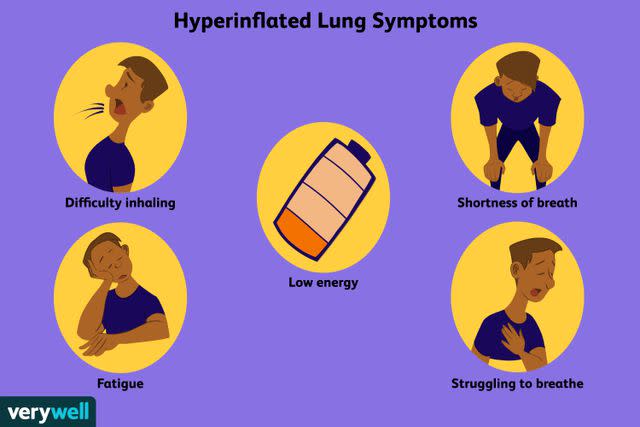An Overview of Hyperinflated Lungs
What to Know About Pulmonary Hyperinflation
Medically reviewed by Sanja Jelic, MD
Hyperinflated lungs are expanded beyond their normal size because there is air trapped in them. Lung hyperinflation is common in people with chronic obstructive lung disease (COPD).
Hyperinflated lungs are also called pulmonary hyperinflation. Overinflation of the lungs means you can't take in as much new air when you breathe, which in turn means there is less oxygen circulating in your body. In addition to causing breathing problems, hyperinflated lungs can also lead to heart failure.
This article will go over the symptoms of hyperinflated lungs, the conditions that can cause pulmonary hyperinflation, and how it's treated.

Laura Porter / Verywell
Learn More: Obstructive vs. Restrictive Lung Disease
Symptoms of Hyperinflated Lungs
The symptoms of hyperinflated lungs are related to the underlying condition that has caused pulmonary hyperinflation.
The reduced ability to exercise (exercise intolerance) is common with lung hyperinflation. You may feel exhausted and short of breath even when you're doing normal activity. In the early stages, extreme exercise intolerance can be the first sign of pulmonary hyperinflation.
Other symptoms of hyperinflated lungs include:
Difficulty inhaling
Difficulty exhaling
Struggling to breath
Shortness of breath
Fatigue
Learn More: What Is Exercise Intolerance?
Complications
Lung hyperinflation can affect the function of the heart. Over time, increased pressure in the chest cavity (thorax) can cause changes in heart filling and function. These changes can reduce the ventricle's ability to pump blood out of the heart, leading to heart failure.
Causes
The major cause of hyperinflated lungs is COPD, which includes:
Emphysema (irreversible enlargement and destruction of the air sacs of the lungs called alveoli)
Chronic bronchitis (narrowing and clogging of the two main airways of the lungs, called the bronchi, due to long-standing inflammation)
Other possible causes of lung hyperinflation include:
Takeaway
Lung hyperinflation can occur in any stage of COPD, but it is usually more severe in the advanced stages. Studies have shown that dynamic hyperinflation (when you start a new breath before fully exhaling) is present in all stages of COPD.
Diagnosis
Pulmonary hyperinflation can be hard to diagnose because the symptoms are commonly seen with other conditions. You'll usually need to see a lung disease specialist (pulmonologist).
Hyperinflated lungs can be diagnosed by a provider through a physical exam, your medical history, and imaging tests.
Your provider will listen for strange breath sounds with a stethoscope. They will also look at your chest and watch how it moves when you breathe, as it can sometimes look abnormal if you have lung hyperinflation from COPD.
Lung hyperinflation can be picked up on imaging tests, including:
Chest X-rays (detailed images of the lungs, heart, and airways)
Computed tomography (CT) scan (multiple X-ray images that create three-dimensional "slices" of the chest cavity)
Your provider may do pulmonary function tests (PFTs) to see how your lungs are working. PFTs measure lung volume, lung capacity, rates of airflow, and the exchange of gases.
Related: Pulmonary Function Tests
Treatment
The treatment for pulmonary hyperinflation depends on what is causing it. Possible treatments for hyperinflated lungs include:
Bronchodilators (medications that help expand the bronchi)
Breathing exercises (such as purse-lipped breathing to help expand the airways)
Oxygen therapy (restores blood oxygen to normal levels)
Lung-volume reduction surgery (relieves compression of the lungs and heart when other treatments have not helped)
Takeaway
Exercises like pursed lip-breathing have been found to improve oxygen saturation at rest in people with COPD. One small study found these exercises also increased exercise tolerance and endurance, and even improved airway capacity in some patients.
Summary
Pulmonary hyperinflation can cause symptoms like shortness of breath, fatigue, difficulty inhaling, and exercise intolerance. The most common cause is COPD, but asthma, cystic fibrosis, and bronchiectasis can also cause lung hyperinflation.
Pulmonary hyperinflation can be diagnosed with a physical exam, imaging tests, and pulmonary function tests (PFTs). Depending on what's causing it, lung hyperinflation can be treated with bronchodilators, breathing exercises, oxygen therapy, or lung-volume reduction surgery.
Learn More: Common Lung Infections
Read the original article on Verywell Health.
